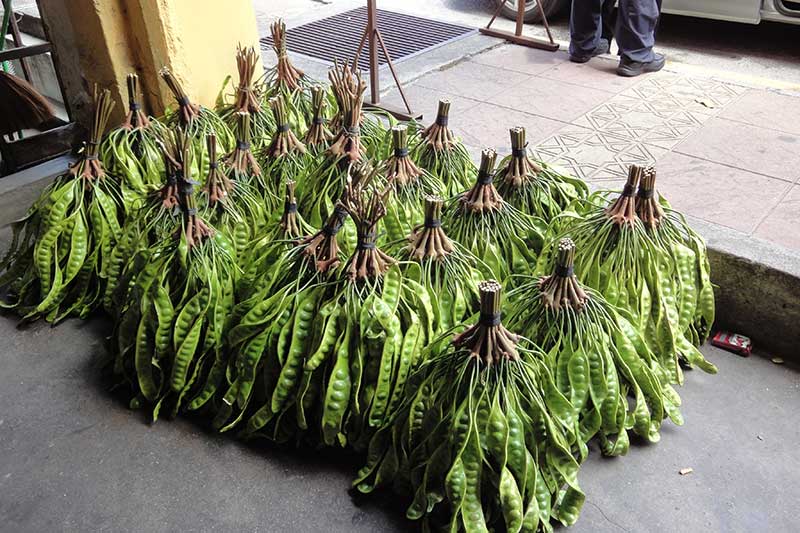ZAWNGTAH (Parkia Speciosa) aka Stink Bean or bitter bean.

Parkia speciosa (bitter bean, twisted cluster bean, or stink bean) is a plant of the genus Parkia in the family Fabaceae. It bears long, flat edible beans with bright green seeds the size and shape of plump almonds which have a rather peculiar smell, similar (but stronger) to the Shiitake mushroom, characterised by some as being similar to natural gas.
The beans or other Parkia species (Parkia javanica and Parkia singalaris for example) are popular as culinary ingredient in Indonesia, Malaysia, Singapore, Laos, southern Thailand, Burma, and northeastern India, and are sold in bunches, still in the pod, or the seeds are sold in plastic bags. Pods are gathered from the wild, or from cultivated trees: they are exported in jars or cans, pickled in brine, or frozen.
It is known as petai, pete in Indonesia, Malaysia and Singapore. In marketplace, depending on the country of origin Parkia species may be labelled peté, petai, yongchaa, yongchaak in Manipur, Zawngṭah (pronounced Zongtrah) among Mizo. They are best when combined with other strongly flavoured foods such as garlic, chili peppers, dried shrimp or shrimp paste, as in sambal petai. When young the pods are flat because the seeds have not yet developed, and they hang like a bunch of slightly twisted ribbons, pale green, almost translucent. At this stage they may be eaten raw, fried or pickled. Young tender pods with undeveloped beans can be used whole in stir-fried dishes.
In Indonesia, petai is very popular in the highlands of Java and Sumatra, especially among Sundanese, Minangkabau and many other people in different cultures of the island. In Sundanese cuisine petai might be eaten raw with sambal as part of lalab, fried or grilled. It also can be stir fried and mixed with oncom. In Java and Sumatra, it also might be added to sayur lodeh or sambal goreng ati petai (fried diced cow or chicken liver in sambal and petai). Nasi goreng kambing petai is popular variant of nasi goreng with goat meat and petai. In Minangkabau cuisine it usually become part of lado (Minang sambal) for ayam pop (Padang style fried chicken).
In India, Parkia is grown in wild in Nungba Sub-Division of Tamenglong District and other parts of Manipur. This wild variety is commonly sold in market. Some species of Parkia are grown in small scale by farmers in northeast India. In mainland India, it is grown as an ornamental plant, shade tree and border tree. This bean has become an important ingredient in many food items in Manipur.
In Manipur, the seeds or the bean as a whole are eaten by preparing a local delicacy called Eromba or Yongchaak singju (salad). Eromba is a very common cuisine in Manipur made with boiled potato, fermented fish, chilly and other vegetables, in this case, Parkia. Yongchaak singju is another favourite side dish made with Parkia cut into small pieces and then mixed with red hot chilly paste. Parkia is also used for making various other dishes with fish and vegetables.The Rongmei Tribe of Manipur, Nagaland and Assam call it KAMPAI which is cooked with meat or prepared as salad. The Zomi tribe of Churachanpur district, Manipur call it Zawngtah (pronounced Zongtah) and mainly prepare it with chilly peppers and a special fermented pork called "Sathu" and called it Zawngtah-hou.
In Malaysia, petai also commonly served with sambal, or mixed with dried shrimp, chili peppers, red onions, belacan (prawn paste), soy sauce and prawn. In Thailand it is called sato (Thai: สะตอ), usually added to a Thai curry such as Thai Duck Green Curry, or as mu phat sato, stink bean with stir fried pork.
In Mizoram, the Mizo people are also very fond of it, and call it Zawngṭah and they use to prepare it with chilli and a fermented pork called Saum. In Manipur, Assam, Tripura and Bangladesh the Manipuris call it Yongchak in the local manipuri dialect and consume as a Salad mixed with fermented fish or the boiled or roasted seeds either alone or in a mash of boiled vegetables laced with fermented fish.
The seeds are also dried and seasoned for later consumption. When dried the seeds turn black. Petai beans or seeds look like broad beans. Like mature broad beans, they may have to be peeled before cooking. Petai has earned its nickname 'stink bean' because its strong smell is very pervasive. It lingers in the mouth and body. Like asparagus, it contains certain amino acids that give a strong smell to one's urine, an effect that can be noticed up to two days after consumption. Like other beans, their complex carbohydrates can also cause strong-smelling flatulence.
